Impact of Racism on the Health of Indigenous Australians
VerifiedAdded on 2023/03/17
|13
|3957
|49
AI Summary
This article discusses the impact of racism on the health of Indigenous Australians. It explores the different types of racism they experience and how it contributes to health disparities. The article also highlights the social determinants of health that affect Indigenous Australians and the government policies and programs aimed at improving their health.
Contribute Materials
Your contribution can guide someone’s learning journey. Share your
documents today.
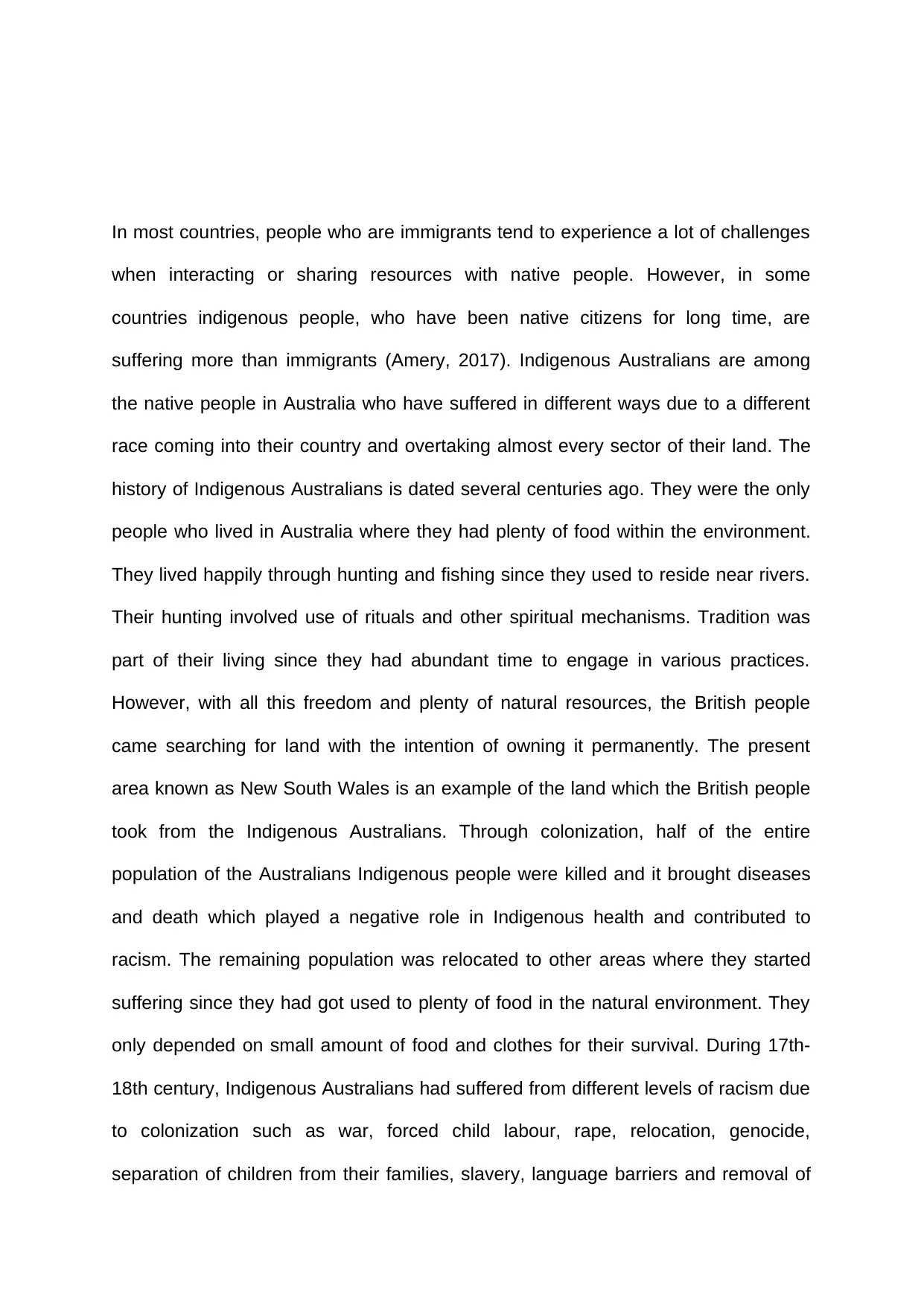
In most countries, people who are immigrants tend to experience a lot of challenges
when interacting or sharing resources with native people. However, in some
countries indigenous people, who have been native citizens for long time, are
suffering more than immigrants (Amery, 2017). Indigenous Australians are among
the native people in Australia who have suffered in different ways due to a different
race coming into their country and overtaking almost every sector of their land. The
history of Indigenous Australians is dated several centuries ago. They were the only
people who lived in Australia where they had plenty of food within the environment.
They lived happily through hunting and fishing since they used to reside near rivers.
Their hunting involved use of rituals and other spiritual mechanisms. Tradition was
part of their living since they had abundant time to engage in various practices.
However, with all this freedom and plenty of natural resources, the British people
came searching for land with the intention of owning it permanently. The present
area known as New South Wales is an example of the land which the British people
took from the Indigenous Australians. Through colonization, half of the entire
population of the Australians Indigenous people were killed and it brought diseases
and death which played a negative role in Indigenous health and contributed to
racism. The remaining population was relocated to other areas where they started
suffering since they had got used to plenty of food in the natural environment. They
only depended on small amount of food and clothes for their survival. During 17th-
18th century, Indigenous Australians had suffered from different levels of racism due
to colonization such as war, forced child labour, rape, relocation, genocide,
separation of children from their families, slavery, language barriers and removal of
when interacting or sharing resources with native people. However, in some
countries indigenous people, who have been native citizens for long time, are
suffering more than immigrants (Amery, 2017). Indigenous Australians are among
the native people in Australia who have suffered in different ways due to a different
race coming into their country and overtaking almost every sector of their land. The
history of Indigenous Australians is dated several centuries ago. They were the only
people who lived in Australia where they had plenty of food within the environment.
They lived happily through hunting and fishing since they used to reside near rivers.
Their hunting involved use of rituals and other spiritual mechanisms. Tradition was
part of their living since they had abundant time to engage in various practices.
However, with all this freedom and plenty of natural resources, the British people
came searching for land with the intention of owning it permanently. The present
area known as New South Wales is an example of the land which the British people
took from the Indigenous Australians. Through colonization, half of the entire
population of the Australians Indigenous people were killed and it brought diseases
and death which played a negative role in Indigenous health and contributed to
racism. The remaining population was relocated to other areas where they started
suffering since they had got used to plenty of food in the natural environment. They
only depended on small amount of food and clothes for their survival. During 17th-
18th century, Indigenous Australians had suffered from different levels of racism due
to colonization such as war, forced child labour, rape, relocation, genocide,
separation of children from their families, slavery, language barriers and removal of
Secure Best Marks with AI Grader
Need help grading? Try our AI Grader for instant feedback on your assignments.
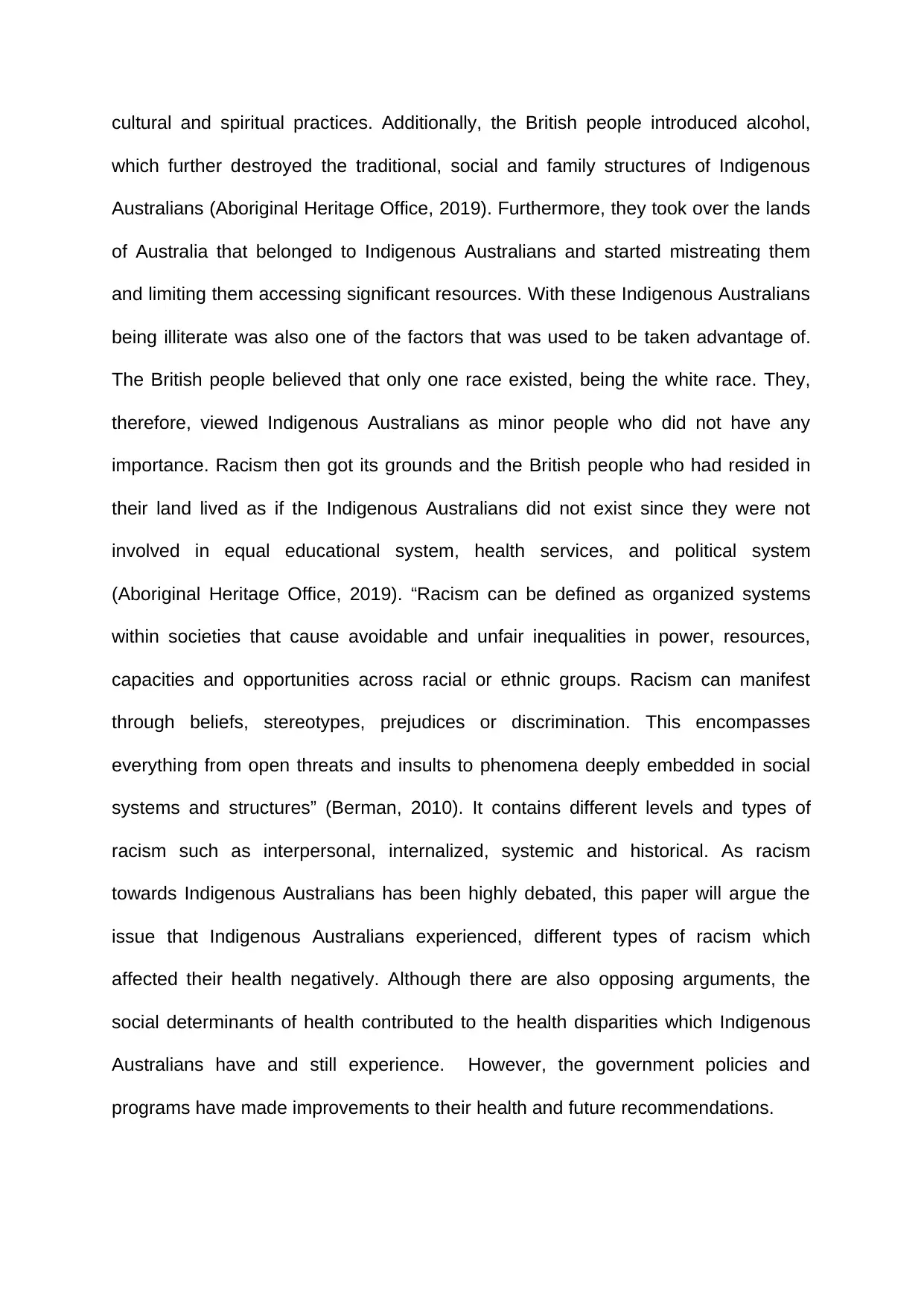
cultural and spiritual practices. Additionally, the British people introduced alcohol,
which further destroyed the traditional, social and family structures of Indigenous
Australians (Aboriginal Heritage Office, 2019). Furthermore, they took over the lands
of Australia that belonged to Indigenous Australians and started mistreating them
and limiting them accessing significant resources. With these Indigenous Australians
being illiterate was also one of the factors that was used to be taken advantage of.
The British people believed that only one race existed, being the white race. They,
therefore, viewed Indigenous Australians as minor people who did not have any
importance. Racism then got its grounds and the British people who had resided in
their land lived as if the Indigenous Australians did not exist since they were not
involved in equal educational system, health services, and political system
(Aboriginal Heritage Office, 2019). “Racism can be defined as organized systems
within societies that cause avoidable and unfair inequalities in power, resources,
capacities and opportunities across racial or ethnic groups. Racism can manifest
through beliefs, stereotypes, prejudices or discrimination. This encompasses
everything from open threats and insults to phenomena deeply embedded in social
systems and structures” (Berman, 2010). It contains different levels and types of
racism such as interpersonal, internalized, systemic and historical. As racism
towards Indigenous Australians has been highly debated, this paper will argue the
issue that Indigenous Australians experienced, different types of racism which
affected their health negatively. Although there are also opposing arguments, the
social determinants of health contributed to the health disparities which Indigenous
Australians have and still experience. However, the government policies and
programs have made improvements to their health and future recommendations.
which further destroyed the traditional, social and family structures of Indigenous
Australians (Aboriginal Heritage Office, 2019). Furthermore, they took over the lands
of Australia that belonged to Indigenous Australians and started mistreating them
and limiting them accessing significant resources. With these Indigenous Australians
being illiterate was also one of the factors that was used to be taken advantage of.
The British people believed that only one race existed, being the white race. They,
therefore, viewed Indigenous Australians as minor people who did not have any
importance. Racism then got its grounds and the British people who had resided in
their land lived as if the Indigenous Australians did not exist since they were not
involved in equal educational system, health services, and political system
(Aboriginal Heritage Office, 2019). “Racism can be defined as organized systems
within societies that cause avoidable and unfair inequalities in power, resources,
capacities and opportunities across racial or ethnic groups. Racism can manifest
through beliefs, stereotypes, prejudices or discrimination. This encompasses
everything from open threats and insults to phenomena deeply embedded in social
systems and structures” (Berman, 2010). It contains different levels and types of
racism such as interpersonal, internalized, systemic and historical. As racism
towards Indigenous Australians has been highly debated, this paper will argue the
issue that Indigenous Australians experienced, different types of racism which
affected their health negatively. Although there are also opposing arguments, the
social determinants of health contributed to the health disparities which Indigenous
Australians have and still experience. However, the government policies and
programs have made improvements to their health and future recommendations.
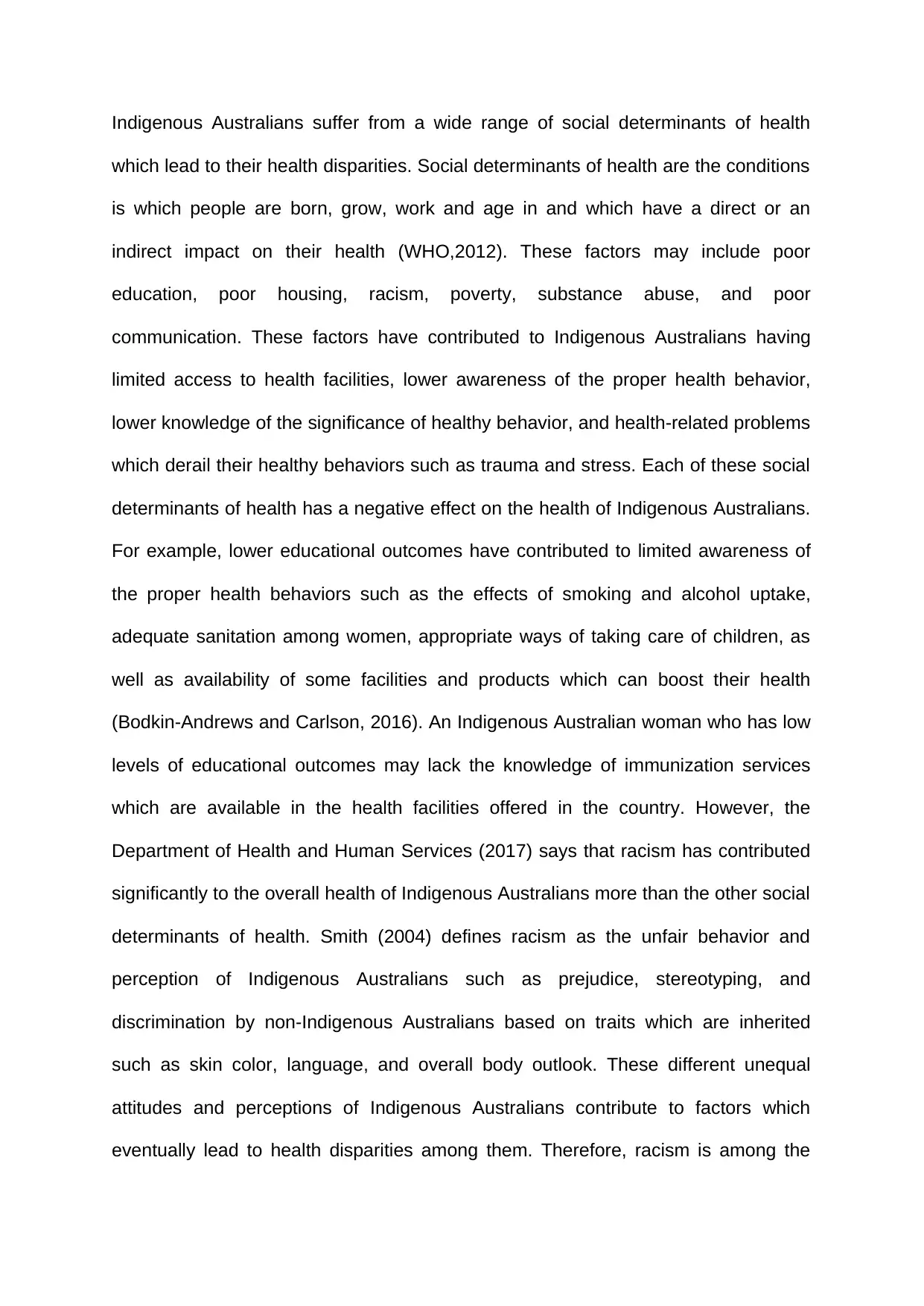
Indigenous Australians suffer from a wide range of social determinants of health
which lead to their health disparities. Social determinants of health are the conditions
is which people are born, grow, work and age in and which have a direct or an
indirect impact on their health (WHO,2012). These factors may include poor
education, poor housing, racism, poverty, substance abuse, and poor
communication. These factors have contributed to Indigenous Australians having
limited access to health facilities, lower awareness of the proper health behavior,
lower knowledge of the significance of healthy behavior, and health-related problems
which derail their healthy behaviors such as trauma and stress. Each of these social
determinants of health has a negative effect on the health of Indigenous Australians.
For example, lower educational outcomes have contributed to limited awareness of
the proper health behaviors such as the effects of smoking and alcohol uptake,
adequate sanitation among women, appropriate ways of taking care of children, as
well as availability of some facilities and products which can boost their health
(Bodkin-Andrews and Carlson, 2016). An Indigenous Australian woman who has low
levels of educational outcomes may lack the knowledge of immunization services
which are available in the health facilities offered in the country. However, the
Department of Health and Human Services (2017) says that racism has contributed
significantly to the overall health of Indigenous Australians more than the other social
determinants of health. Smith (2004) defines racism as the unfair behavior and
perception of Indigenous Australians such as prejudice, stereotyping, and
discrimination by non-Indigenous Australians based on traits which are inherited
such as skin color, language, and overall body outlook. These different unequal
attitudes and perceptions of Indigenous Australians contribute to factors which
eventually lead to health disparities among them. Therefore, racism is among the
which lead to their health disparities. Social determinants of health are the conditions
is which people are born, grow, work and age in and which have a direct or an
indirect impact on their health (WHO,2012). These factors may include poor
education, poor housing, racism, poverty, substance abuse, and poor
communication. These factors have contributed to Indigenous Australians having
limited access to health facilities, lower awareness of the proper health behavior,
lower knowledge of the significance of healthy behavior, and health-related problems
which derail their healthy behaviors such as trauma and stress. Each of these social
determinants of health has a negative effect on the health of Indigenous Australians.
For example, lower educational outcomes have contributed to limited awareness of
the proper health behaviors such as the effects of smoking and alcohol uptake,
adequate sanitation among women, appropriate ways of taking care of children, as
well as availability of some facilities and products which can boost their health
(Bodkin-Andrews and Carlson, 2016). An Indigenous Australian woman who has low
levels of educational outcomes may lack the knowledge of immunization services
which are available in the health facilities offered in the country. However, the
Department of Health and Human Services (2017) says that racism has contributed
significantly to the overall health of Indigenous Australians more than the other social
determinants of health. Smith (2004) defines racism as the unfair behavior and
perception of Indigenous Australians such as prejudice, stereotyping, and
discrimination by non-Indigenous Australians based on traits which are inherited
such as skin color, language, and overall body outlook. These different unequal
attitudes and perceptions of Indigenous Australians contribute to factors which
eventually lead to health disparities among them. Therefore, racism is among the

social determinants of health which acts as a barrier to the overall health of
Indigenous Australians. In most cases, non-Indigenous Australians tend to view
themselves as being superior to Indigenous Australians, and this affects the way
they perceive them, as well as the way they interact and offer opportunities to them.
There are different types of racism which Indigenous Australians experience which
include direct, interpersonal, internalized, systemic, and historical racism. Shepherd
et al. (2017) argue that direct racism exists in an individual where one has certain
assumptions, beliefs, and behavior which stems from both conscious and
unconscious personal prejudice. For example, non-Indigenous Australians have the
perception that Indigenous Australians have traits which contribute to their poor
health and also perceive them as being inferior. This aspect affects the way non-
Indigenous Australians interact with Indigenous Australians such as the kinds of
medical help offered to them in health institutions.
Interpersonal racism involves negative attitudes which a particular individual holds
against another individual. It can also be negative attitudes of a specific group
towards another group. Indigenous Australians are victims of interpersonal racism
where non-Indigenous Australians tend to view them as less necessary in society
and as the leading cause of problems experienced in society (Rigby et al., 2011).
The rate of interpersonal racism has been reported to be very high in Australia and
has affected Victorians negatively. A percentage of 34% of Aboriginal Victorians
reported to have suffered from this form of racism for more than two times in a month
(Paradies, Harris and Anderson, 2008). Moreover, Interpersonal racism has been
reported to have affected Indigenous Australians in the way non-Indigenous
Australians treat them. Indigenous Australians who have had direct experience with
racism have been found to have health problems. A study carried out by Ferdinand,
Indigenous Australians. In most cases, non-Indigenous Australians tend to view
themselves as being superior to Indigenous Australians, and this affects the way
they perceive them, as well as the way they interact and offer opportunities to them.
There are different types of racism which Indigenous Australians experience which
include direct, interpersonal, internalized, systemic, and historical racism. Shepherd
et al. (2017) argue that direct racism exists in an individual where one has certain
assumptions, beliefs, and behavior which stems from both conscious and
unconscious personal prejudice. For example, non-Indigenous Australians have the
perception that Indigenous Australians have traits which contribute to their poor
health and also perceive them as being inferior. This aspect affects the way non-
Indigenous Australians interact with Indigenous Australians such as the kinds of
medical help offered to them in health institutions.
Interpersonal racism involves negative attitudes which a particular individual holds
against another individual. It can also be negative attitudes of a specific group
towards another group. Indigenous Australians are victims of interpersonal racism
where non-Indigenous Australians tend to view them as less necessary in society
and as the leading cause of problems experienced in society (Rigby et al., 2011).
The rate of interpersonal racism has been reported to be very high in Australia and
has affected Victorians negatively. A percentage of 34% of Aboriginal Victorians
reported to have suffered from this form of racism for more than two times in a month
(Paradies, Harris and Anderson, 2008). Moreover, Interpersonal racism has been
reported to have affected Indigenous Australians in the way non-Indigenous
Australians treat them. Indigenous Australians who have had direct experience with
racism have been found to have health problems. A study carried out by Ferdinand,
Secure Best Marks with AI Grader
Need help grading? Try our AI Grader for instant feedback on your assignments.
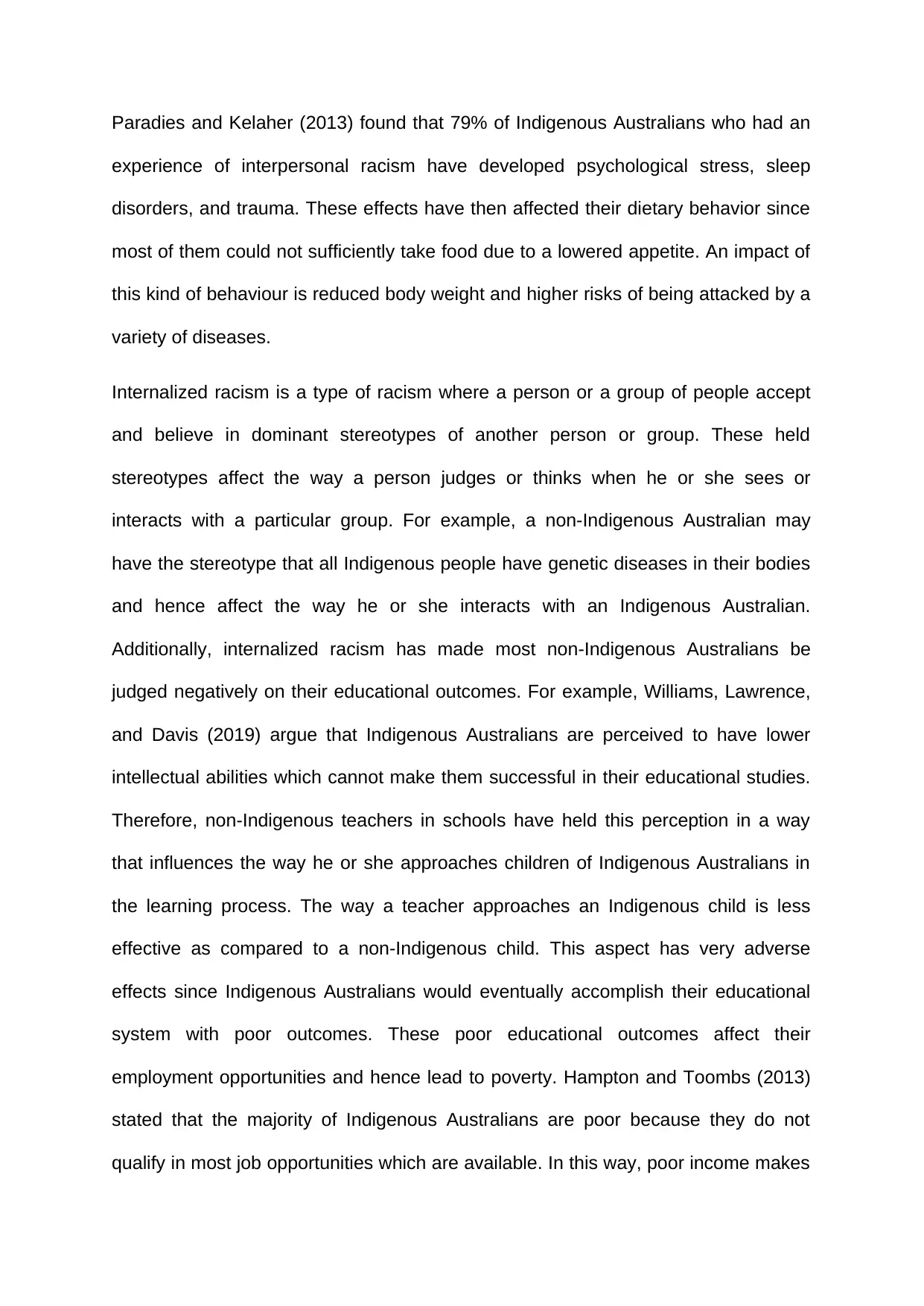
Paradies and Kelaher (2013) found that 79% of Indigenous Australians who had an
experience of interpersonal racism have developed psychological stress, sleep
disorders, and trauma. These effects have then affected their dietary behavior since
most of them could not sufficiently take food due to a lowered appetite. An impact of
this kind of behaviour is reduced body weight and higher risks of being attacked by a
variety of diseases.
Internalized racism is a type of racism where a person or a group of people accept
and believe in dominant stereotypes of another person or group. These held
stereotypes affect the way a person judges or thinks when he or she sees or
interacts with a particular group. For example, a non-Indigenous Australian may
have the stereotype that all Indigenous people have genetic diseases in their bodies
and hence affect the way he or she interacts with an Indigenous Australian.
Additionally, internalized racism has made most non-Indigenous Australians be
judged negatively on their educational outcomes. For example, Williams, Lawrence,
and Davis (2019) argue that Indigenous Australians are perceived to have lower
intellectual abilities which cannot make them successful in their educational studies.
Therefore, non-Indigenous teachers in schools have held this perception in a way
that influences the way he or she approaches children of Indigenous Australians in
the learning process. The way a teacher approaches an Indigenous child is less
effective as compared to a non-Indigenous child. This aspect has very adverse
effects since Indigenous Australians would eventually accomplish their educational
system with poor outcomes. These poor educational outcomes affect their
employment opportunities and hence lead to poverty. Hampton and Toombs (2013)
stated that the majority of Indigenous Australians are poor because they do not
qualify in most job opportunities which are available. In this way, poor income makes
experience of interpersonal racism have developed psychological stress, sleep
disorders, and trauma. These effects have then affected their dietary behavior since
most of them could not sufficiently take food due to a lowered appetite. An impact of
this kind of behaviour is reduced body weight and higher risks of being attacked by a
variety of diseases.
Internalized racism is a type of racism where a person or a group of people accept
and believe in dominant stereotypes of another person or group. These held
stereotypes affect the way a person judges or thinks when he or she sees or
interacts with a particular group. For example, a non-Indigenous Australian may
have the stereotype that all Indigenous people have genetic diseases in their bodies
and hence affect the way he or she interacts with an Indigenous Australian.
Additionally, internalized racism has made most non-Indigenous Australians be
judged negatively on their educational outcomes. For example, Williams, Lawrence,
and Davis (2019) argue that Indigenous Australians are perceived to have lower
intellectual abilities which cannot make them successful in their educational studies.
Therefore, non-Indigenous teachers in schools have held this perception in a way
that influences the way he or she approaches children of Indigenous Australians in
the learning process. The way a teacher approaches an Indigenous child is less
effective as compared to a non-Indigenous child. This aspect has very adverse
effects since Indigenous Australians would eventually accomplish their educational
system with poor outcomes. These poor educational outcomes affect their
employment opportunities and hence lead to poverty. Hampton and Toombs (2013)
stated that the majority of Indigenous Australians are poor because they do not
qualify in most job opportunities which are available. In this way, poor income makes
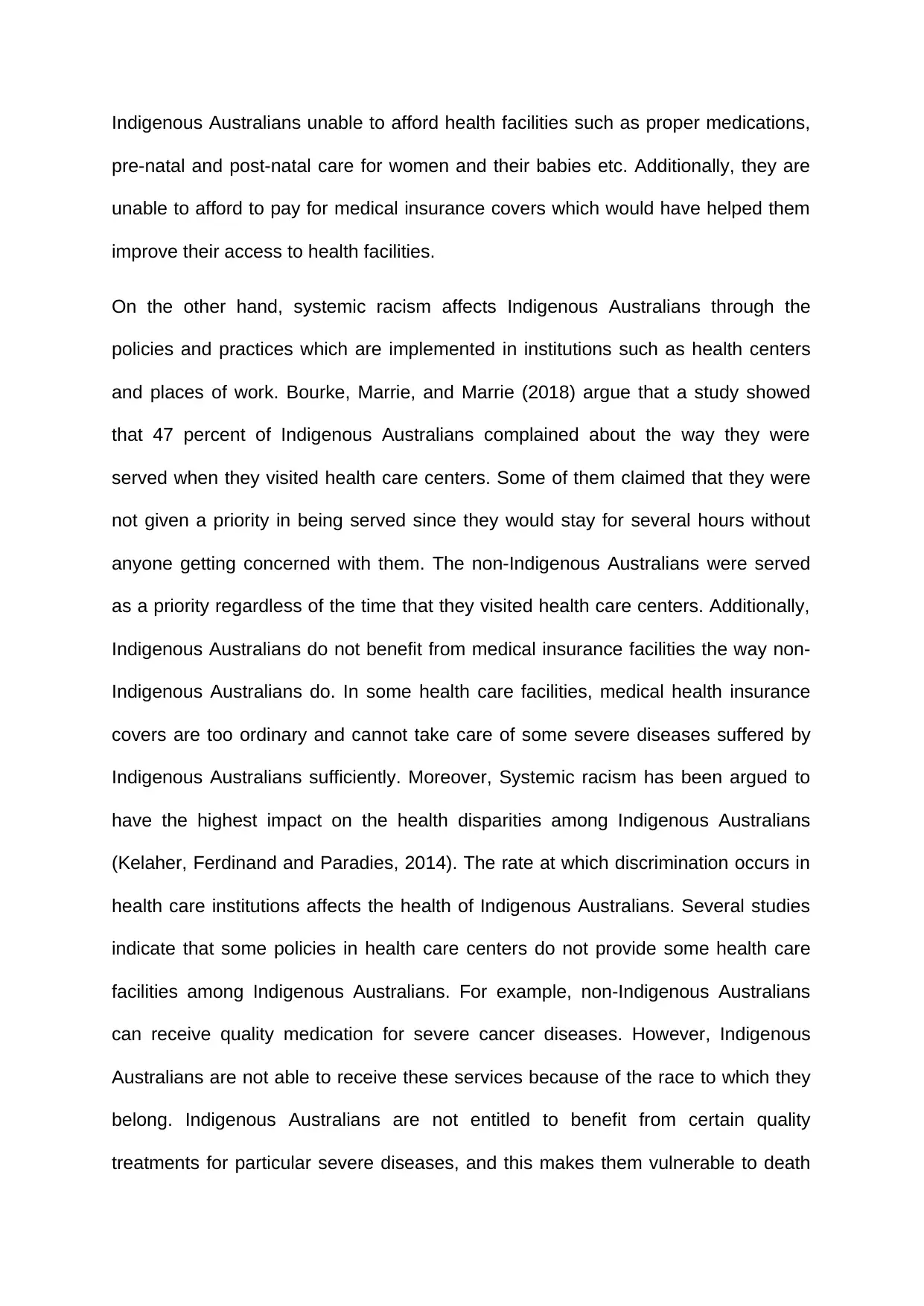
Indigenous Australians unable to afford health facilities such as proper medications,
pre-natal and post-natal care for women and their babies etc. Additionally, they are
unable to afford to pay for medical insurance covers which would have helped them
improve their access to health facilities.
On the other hand, systemic racism affects Indigenous Australians through the
policies and practices which are implemented in institutions such as health centers
and places of work. Bourke, Marrie, and Marrie (2018) argue that a study showed
that 47 percent of Indigenous Australians complained about the way they were
served when they visited health care centers. Some of them claimed that they were
not given a priority in being served since they would stay for several hours without
anyone getting concerned with them. The non-Indigenous Australians were served
as a priority regardless of the time that they visited health care centers. Additionally,
Indigenous Australians do not benefit from medical insurance facilities the way non-
Indigenous Australians do. In some health care facilities, medical health insurance
covers are too ordinary and cannot take care of some severe diseases suffered by
Indigenous Australians sufficiently. Moreover, Systemic racism has been argued to
have the highest impact on the health disparities among Indigenous Australians
(Kelaher, Ferdinand and Paradies, 2014). The rate at which discrimination occurs in
health care institutions affects the health of Indigenous Australians. Several studies
indicate that some policies in health care centers do not provide some health care
facilities among Indigenous Australians. For example, non-Indigenous Australians
can receive quality medication for severe cancer diseases. However, Indigenous
Australians are not able to receive these services because of the race to which they
belong. Indigenous Australians are not entitled to benefit from certain quality
treatments for particular severe diseases, and this makes them vulnerable to death
pre-natal and post-natal care for women and their babies etc. Additionally, they are
unable to afford to pay for medical insurance covers which would have helped them
improve their access to health facilities.
On the other hand, systemic racism affects Indigenous Australians through the
policies and practices which are implemented in institutions such as health centers
and places of work. Bourke, Marrie, and Marrie (2018) argue that a study showed
that 47 percent of Indigenous Australians complained about the way they were
served when they visited health care centers. Some of them claimed that they were
not given a priority in being served since they would stay for several hours without
anyone getting concerned with them. The non-Indigenous Australians were served
as a priority regardless of the time that they visited health care centers. Additionally,
Indigenous Australians do not benefit from medical insurance facilities the way non-
Indigenous Australians do. In some health care facilities, medical health insurance
covers are too ordinary and cannot take care of some severe diseases suffered by
Indigenous Australians sufficiently. Moreover, Systemic racism has been argued to
have the highest impact on the health disparities among Indigenous Australians
(Kelaher, Ferdinand and Paradies, 2014). The rate at which discrimination occurs in
health care institutions affects the health of Indigenous Australians. Several studies
indicate that some policies in health care centers do not provide some health care
facilities among Indigenous Australians. For example, non-Indigenous Australians
can receive quality medication for severe cancer diseases. However, Indigenous
Australians are not able to receive these services because of the race to which they
belong. Indigenous Australians are not entitled to benefit from certain quality
treatments for particular severe diseases, and this makes them vulnerable to death
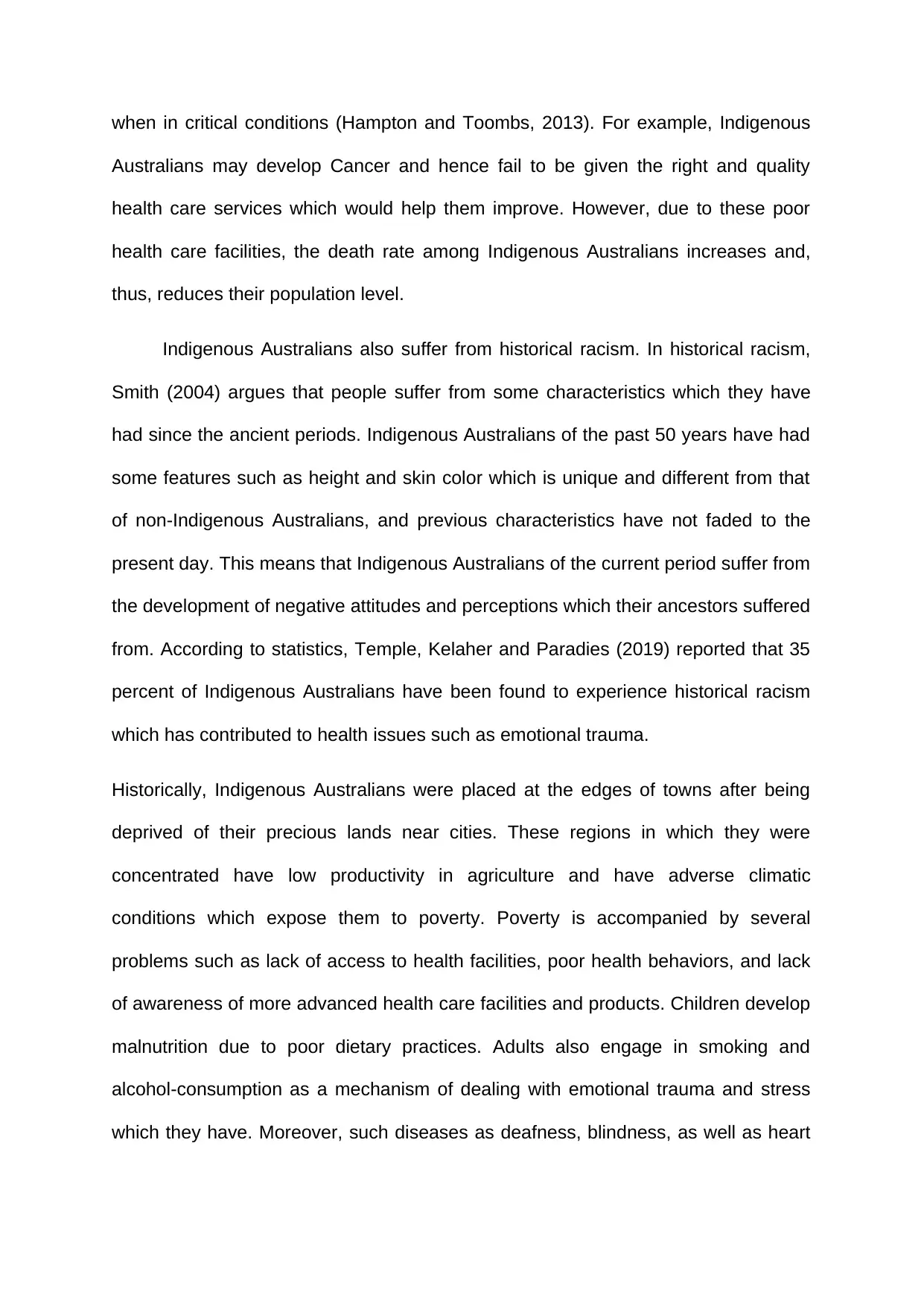
when in critical conditions (Hampton and Toombs, 2013). For example, Indigenous
Australians may develop Cancer and hence fail to be given the right and quality
health care services which would help them improve. However, due to these poor
health care facilities, the death rate among Indigenous Australians increases and,
thus, reduces their population level.
Indigenous Australians also suffer from historical racism. In historical racism,
Smith (2004) argues that people suffer from some characteristics which they have
had since the ancient periods. Indigenous Australians of the past 50 years have had
some features such as height and skin color which is unique and different from that
of non-Indigenous Australians, and previous characteristics have not faded to the
present day. This means that Indigenous Australians of the current period suffer from
the development of negative attitudes and perceptions which their ancestors suffered
from. According to statistics, Temple, Kelaher and Paradies (2019) reported that 35
percent of Indigenous Australians have been found to experience historical racism
which has contributed to health issues such as emotional trauma.
Historically, Indigenous Australians were placed at the edges of towns after being
deprived of their precious lands near cities. These regions in which they were
concentrated have low productivity in agriculture and have adverse climatic
conditions which expose them to poverty. Poverty is accompanied by several
problems such as lack of access to health facilities, poor health behaviors, and lack
of awareness of more advanced health care facilities and products. Children develop
malnutrition due to poor dietary practices. Adults also engage in smoking and
alcohol-consumption as a mechanism of dealing with emotional trauma and stress
which they have. Moreover, such diseases as deafness, blindness, as well as heart
Australians may develop Cancer and hence fail to be given the right and quality
health care services which would help them improve. However, due to these poor
health care facilities, the death rate among Indigenous Australians increases and,
thus, reduces their population level.
Indigenous Australians also suffer from historical racism. In historical racism,
Smith (2004) argues that people suffer from some characteristics which they have
had since the ancient periods. Indigenous Australians of the past 50 years have had
some features such as height and skin color which is unique and different from that
of non-Indigenous Australians, and previous characteristics have not faded to the
present day. This means that Indigenous Australians of the current period suffer from
the development of negative attitudes and perceptions which their ancestors suffered
from. According to statistics, Temple, Kelaher and Paradies (2019) reported that 35
percent of Indigenous Australians have been found to experience historical racism
which has contributed to health issues such as emotional trauma.
Historically, Indigenous Australians were placed at the edges of towns after being
deprived of their precious lands near cities. These regions in which they were
concentrated have low productivity in agriculture and have adverse climatic
conditions which expose them to poverty. Poverty is accompanied by several
problems such as lack of access to health facilities, poor health behaviors, and lack
of awareness of more advanced health care facilities and products. Children develop
malnutrition due to poor dietary practices. Adults also engage in smoking and
alcohol-consumption as a mechanism of dealing with emotional trauma and stress
which they have. Moreover, such diseases as deafness, blindness, as well as heart
Paraphrase This Document
Need a fresh take? Get an instant paraphrase of this document with our AI Paraphraser

diseases develop in children due to the lack of affordability of health care facilities
(Smith, 2004).
The stolen generation is argued to be another cause of the health disparities among
Indigenous Australians and impacted on their mental health. The stolen generation
which consisted of children was a perfect example of how racism impacted on their
health by being taken from their families and adopted into the white race. However,
these children received minimal, if any, affection in school since they were
discriminated by the white children and teachers (Terszak, 2015). They were also
highly punished and received minimal education since they were expected to serve
as casual laborers. This stolen generation was mistreated in the families in which
they were adopted through physical, psychological and sexual abuse. They were
also forced to abandon their Indigenous culture. These adverse experiences
increased their health since reports showed that most of them developed post-
traumatic stress, depression, anxiety and cases of suicide increased (Terszak,
2015). The parents of these children were also unable to live peacefully without their
children. They developed trauma, anxiety, stress and other psychological problems.
They also involved themselves in alcohol and drugs abuse as a way to cope with
such psychological problems. Others were unable to sustain this loss of their
children and ended up committing suicide.
In estimating the health level of a population, there are several variables which are
considered. In Australia, a comparison between the health of Indigenous Australians
and non-Indigenous Australians can be made through their life expectancy, chronic
diseases, and substance abuse. Statistics show that in whichever age, Indigenous
Australians have a lower life expectancy as compared to non-Indigenous
Australians. Most Indigenous Australian adults die before the age of 45 years.
(Smith, 2004).
The stolen generation is argued to be another cause of the health disparities among
Indigenous Australians and impacted on their mental health. The stolen generation
which consisted of children was a perfect example of how racism impacted on their
health by being taken from their families and adopted into the white race. However,
these children received minimal, if any, affection in school since they were
discriminated by the white children and teachers (Terszak, 2015). They were also
highly punished and received minimal education since they were expected to serve
as casual laborers. This stolen generation was mistreated in the families in which
they were adopted through physical, psychological and sexual abuse. They were
also forced to abandon their Indigenous culture. These adverse experiences
increased their health since reports showed that most of them developed post-
traumatic stress, depression, anxiety and cases of suicide increased (Terszak,
2015). The parents of these children were also unable to live peacefully without their
children. They developed trauma, anxiety, stress and other psychological problems.
They also involved themselves in alcohol and drugs abuse as a way to cope with
such psychological problems. Others were unable to sustain this loss of their
children and ended up committing suicide.
In estimating the health level of a population, there are several variables which are
considered. In Australia, a comparison between the health of Indigenous Australians
and non-Indigenous Australians can be made through their life expectancy, chronic
diseases, and substance abuse. Statistics show that in whichever age, Indigenous
Australians have a lower life expectancy as compared to non-Indigenous
Australians. Most Indigenous Australian adults die before the age of 45 years.
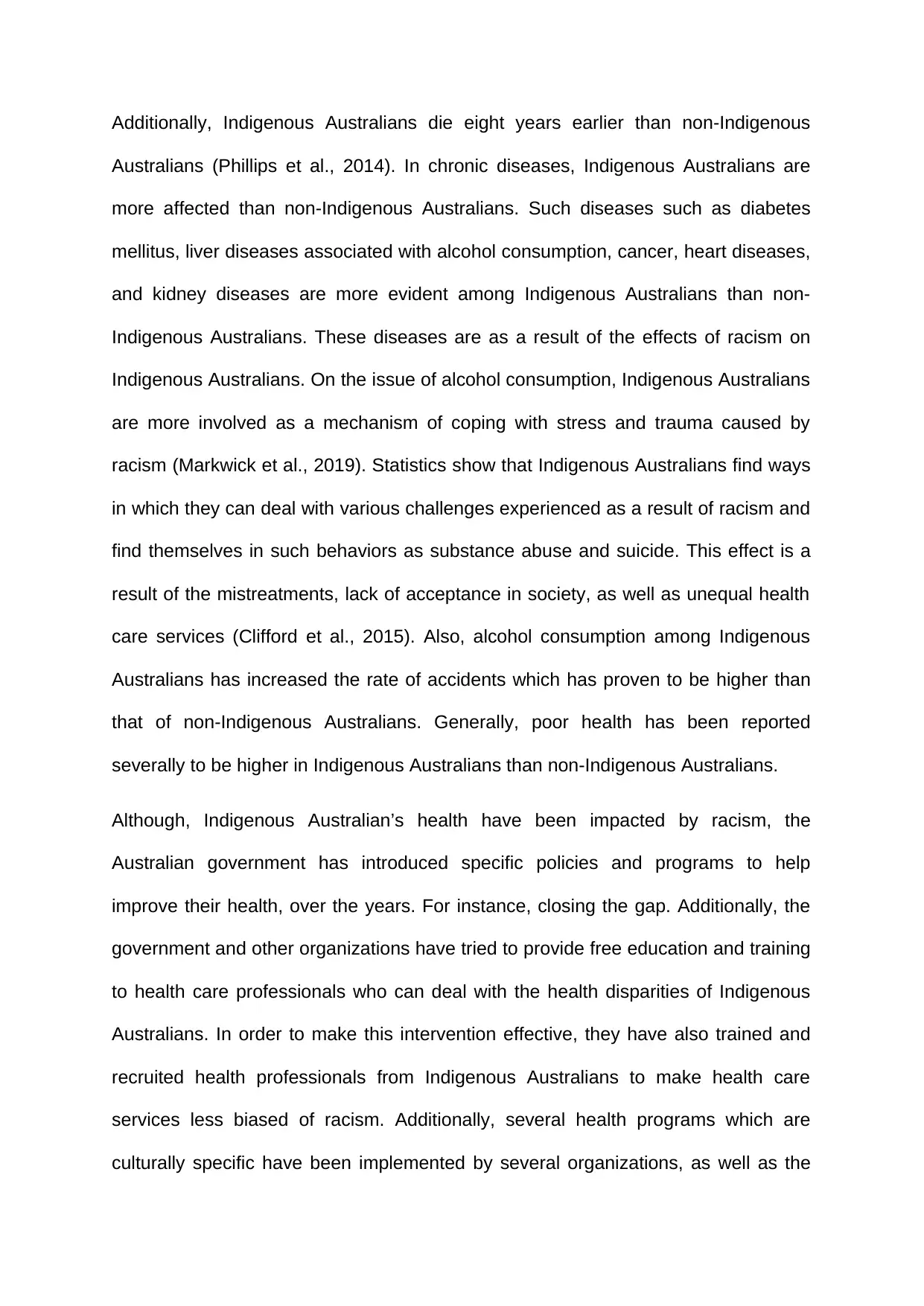
Additionally, Indigenous Australians die eight years earlier than non-Indigenous
Australians (Phillips et al., 2014). In chronic diseases, Indigenous Australians are
more affected than non-Indigenous Australians. Such diseases such as diabetes
mellitus, liver diseases associated with alcohol consumption, cancer, heart diseases,
and kidney diseases are more evident among Indigenous Australians than non-
Indigenous Australians. These diseases are as a result of the effects of racism on
Indigenous Australians. On the issue of alcohol consumption, Indigenous Australians
are more involved as a mechanism of coping with stress and trauma caused by
racism (Markwick et al., 2019). Statistics show that Indigenous Australians find ways
in which they can deal with various challenges experienced as a result of racism and
find themselves in such behaviors as substance abuse and suicide. This effect is a
result of the mistreatments, lack of acceptance in society, as well as unequal health
care services (Clifford et al., 2015). Also, alcohol consumption among Indigenous
Australians has increased the rate of accidents which has proven to be higher than
that of non-Indigenous Australians. Generally, poor health has been reported
severally to be higher in Indigenous Australians than non-Indigenous Australians.
Although, Indigenous Australian’s health have been impacted by racism, the
Australian government has introduced specific policies and programs to help
improve their health, over the years. For instance, closing the gap. Additionally, the
government and other organizations have tried to provide free education and training
to health care professionals who can deal with the health disparities of Indigenous
Australians. In order to make this intervention effective, they have also trained and
recruited health professionals from Indigenous Australians to make health care
services less biased of racism. Additionally, several health programs which are
culturally specific have been implemented by several organizations, as well as the
Australians (Phillips et al., 2014). In chronic diseases, Indigenous Australians are
more affected than non-Indigenous Australians. Such diseases such as diabetes
mellitus, liver diseases associated with alcohol consumption, cancer, heart diseases,
and kidney diseases are more evident among Indigenous Australians than non-
Indigenous Australians. These diseases are as a result of the effects of racism on
Indigenous Australians. On the issue of alcohol consumption, Indigenous Australians
are more involved as a mechanism of coping with stress and trauma caused by
racism (Markwick et al., 2019). Statistics show that Indigenous Australians find ways
in which they can deal with various challenges experienced as a result of racism and
find themselves in such behaviors as substance abuse and suicide. This effect is a
result of the mistreatments, lack of acceptance in society, as well as unequal health
care services (Clifford et al., 2015). Also, alcohol consumption among Indigenous
Australians has increased the rate of accidents which has proven to be higher than
that of non-Indigenous Australians. Generally, poor health has been reported
severally to be higher in Indigenous Australians than non-Indigenous Australians.
Although, Indigenous Australian’s health have been impacted by racism, the
Australian government has introduced specific policies and programs to help
improve their health, over the years. For instance, closing the gap. Additionally, the
government and other organizations have tried to provide free education and training
to health care professionals who can deal with the health disparities of Indigenous
Australians. In order to make this intervention effective, they have also trained and
recruited health professionals from Indigenous Australians to make health care
services less biased of racism. Additionally, several health programs which are
culturally specific have been implemented by several organizations, as well as the
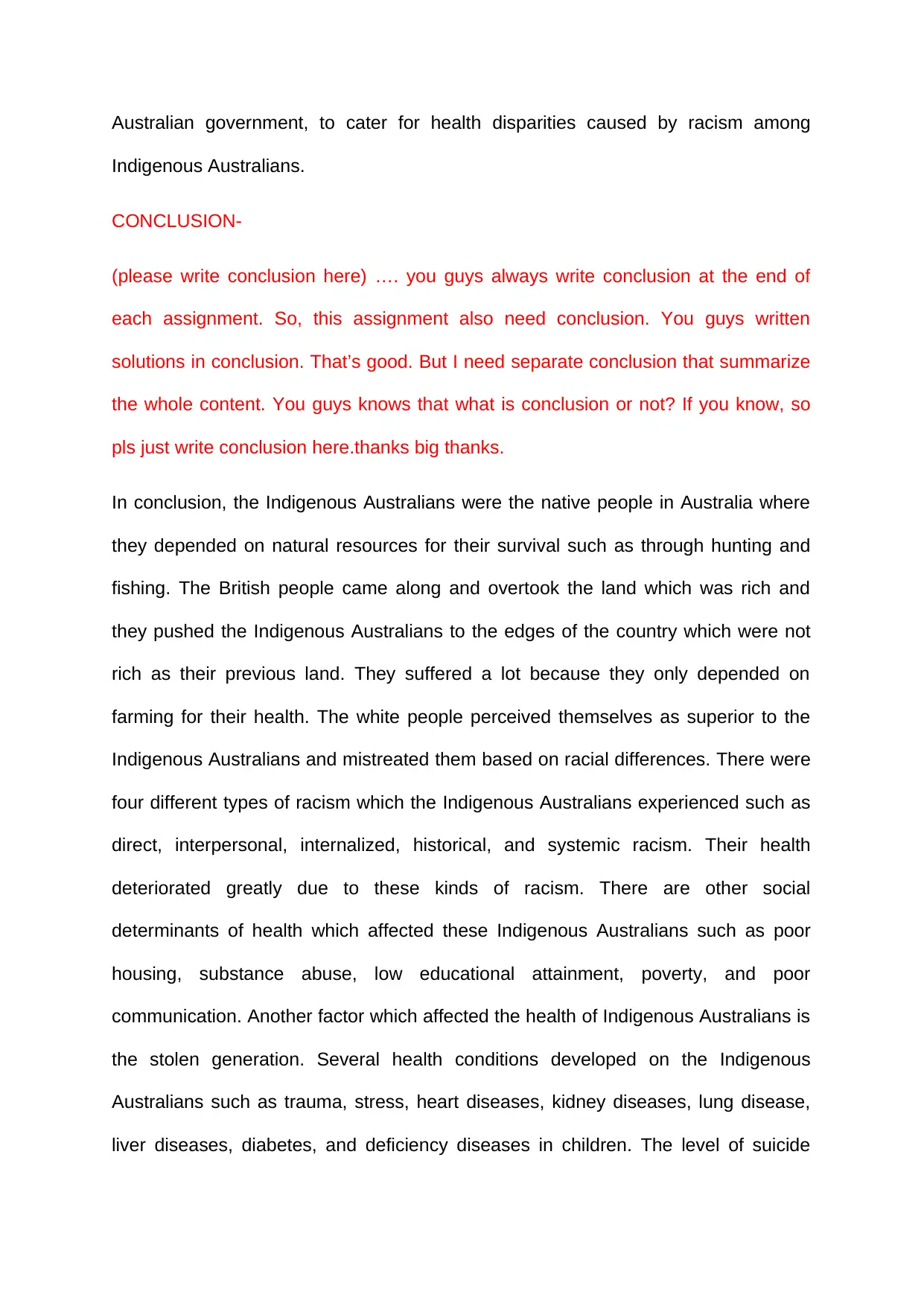
Australian government, to cater for health disparities caused by racism among
Indigenous Australians.
CONCLUSION-
(please write conclusion here) …. you guys always write conclusion at the end of
each assignment. So, this assignment also need conclusion. You guys written
solutions in conclusion. That’s good. But I need separate conclusion that summarize
the whole content. You guys knows that what is conclusion or not? If you know, so
pls just write conclusion here.thanks big thanks.
In conclusion, the Indigenous Australians were the native people in Australia where
they depended on natural resources for their survival such as through hunting and
fishing. The British people came along and overtook the land which was rich and
they pushed the Indigenous Australians to the edges of the country which were not
rich as their previous land. They suffered a lot because they only depended on
farming for their health. The white people perceived themselves as superior to the
Indigenous Australians and mistreated them based on racial differences. There were
four different types of racism which the Indigenous Australians experienced such as
direct, interpersonal, internalized, historical, and systemic racism. Their health
deteriorated greatly due to these kinds of racism. There are other social
determinants of health which affected these Indigenous Australians such as poor
housing, substance abuse, low educational attainment, poverty, and poor
communication. Another factor which affected the health of Indigenous Australians is
the stolen generation. Several health conditions developed on the Indigenous
Australians such as trauma, stress, heart diseases, kidney diseases, lung disease,
liver diseases, diabetes, and deficiency diseases in children. The level of suicide
Indigenous Australians.
CONCLUSION-
(please write conclusion here) …. you guys always write conclusion at the end of
each assignment. So, this assignment also need conclusion. You guys written
solutions in conclusion. That’s good. But I need separate conclusion that summarize
the whole content. You guys knows that what is conclusion or not? If you know, so
pls just write conclusion here.thanks big thanks.
In conclusion, the Indigenous Australians were the native people in Australia where
they depended on natural resources for their survival such as through hunting and
fishing. The British people came along and overtook the land which was rich and
they pushed the Indigenous Australians to the edges of the country which were not
rich as their previous land. They suffered a lot because they only depended on
farming for their health. The white people perceived themselves as superior to the
Indigenous Australians and mistreated them based on racial differences. There were
four different types of racism which the Indigenous Australians experienced such as
direct, interpersonal, internalized, historical, and systemic racism. Their health
deteriorated greatly due to these kinds of racism. There are other social
determinants of health which affected these Indigenous Australians such as poor
housing, substance abuse, low educational attainment, poverty, and poor
communication. Another factor which affected the health of Indigenous Australians is
the stolen generation. Several health conditions developed on the Indigenous
Australians such as trauma, stress, heart diseases, kidney diseases, lung disease,
liver diseases, diabetes, and deficiency diseases in children. The level of suicide
Secure Best Marks with AI Grader
Need help grading? Try our AI Grader for instant feedback on your assignments.
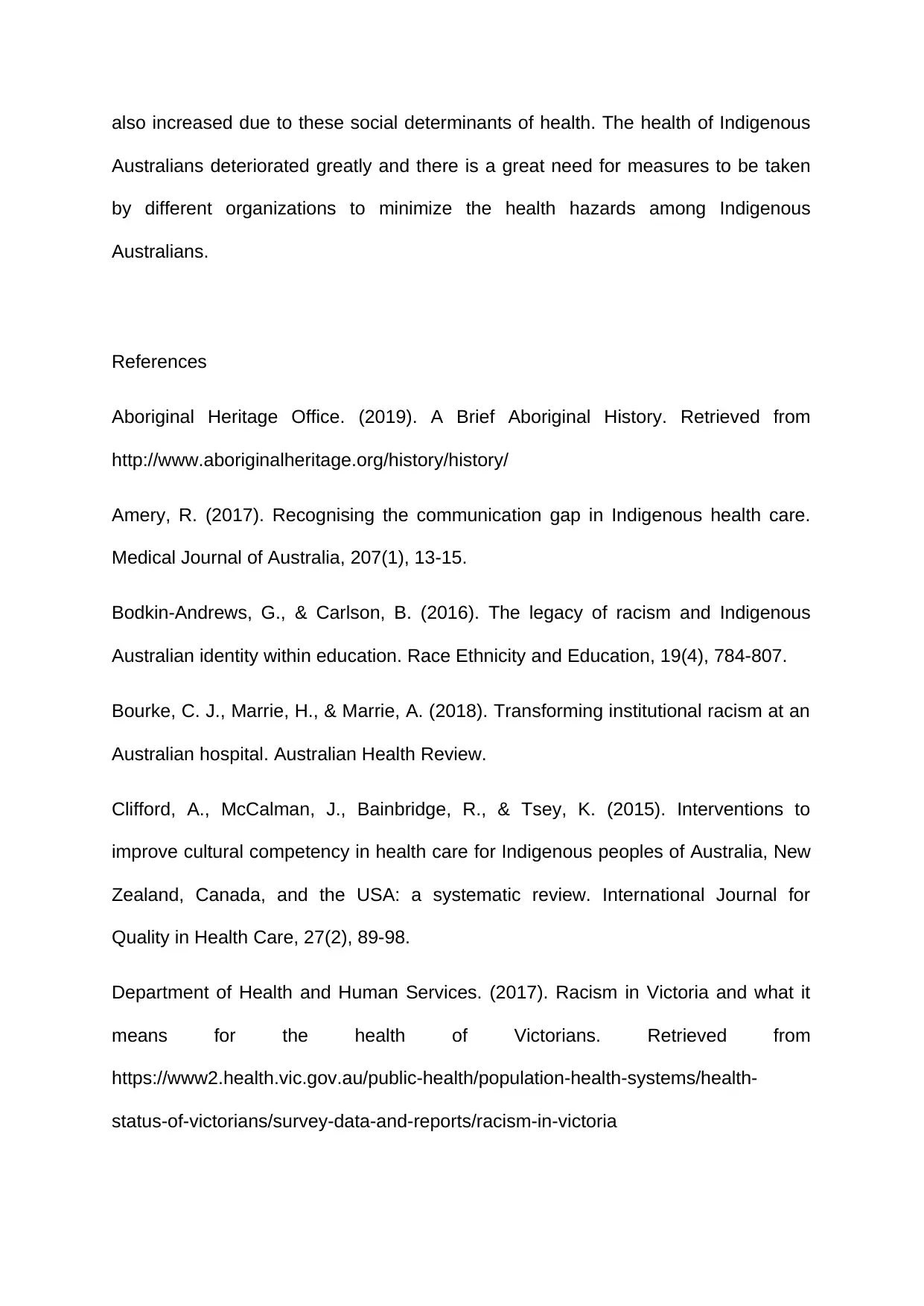
also increased due to these social determinants of health. The health of Indigenous
Australians deteriorated greatly and there is a great need for measures to be taken
by different organizations to minimize the health hazards among Indigenous
Australians.
References
Aboriginal Heritage Office. (2019). A Brief Aboriginal History. Retrieved from
http://www.aboriginalheritage.org/history/history/
Amery, R. (2017). Recognising the communication gap in Indigenous health care.
Medical Journal of Australia, 207(1), 13-15.
Bodkin-Andrews, G., & Carlson, B. (2016). The legacy of racism and Indigenous
Australian identity within education. Race Ethnicity and Education, 19(4), 784-807.
Bourke, C. J., Marrie, H., & Marrie, A. (2018). Transforming institutional racism at an
Australian hospital. Australian Health Review.
Clifford, A., McCalman, J., Bainbridge, R., & Tsey, K. (2015). Interventions to
improve cultural competency in health care for Indigenous peoples of Australia, New
Zealand, Canada, and the USA: a systematic review. International Journal for
Quality in Health Care, 27(2), 89-98.
Department of Health and Human Services. (2017). Racism in Victoria and what it
means for the health of Victorians. Retrieved from
https://www2.health.vic.gov.au/public-health/population-health-systems/health-
status-of-victorians/survey-data-and-reports/racism-in-victoria
Australians deteriorated greatly and there is a great need for measures to be taken
by different organizations to minimize the health hazards among Indigenous
Australians.
References
Aboriginal Heritage Office. (2019). A Brief Aboriginal History. Retrieved from
http://www.aboriginalheritage.org/history/history/
Amery, R. (2017). Recognising the communication gap in Indigenous health care.
Medical Journal of Australia, 207(1), 13-15.
Bodkin-Andrews, G., & Carlson, B. (2016). The legacy of racism and Indigenous
Australian identity within education. Race Ethnicity and Education, 19(4), 784-807.
Bourke, C. J., Marrie, H., & Marrie, A. (2018). Transforming institutional racism at an
Australian hospital. Australian Health Review.
Clifford, A., McCalman, J., Bainbridge, R., & Tsey, K. (2015). Interventions to
improve cultural competency in health care for Indigenous peoples of Australia, New
Zealand, Canada, and the USA: a systematic review. International Journal for
Quality in Health Care, 27(2), 89-98.
Department of Health and Human Services. (2017). Racism in Victoria and what it
means for the health of Victorians. Retrieved from
https://www2.health.vic.gov.au/public-health/population-health-systems/health-
status-of-victorians/survey-data-and-reports/racism-in-victoria
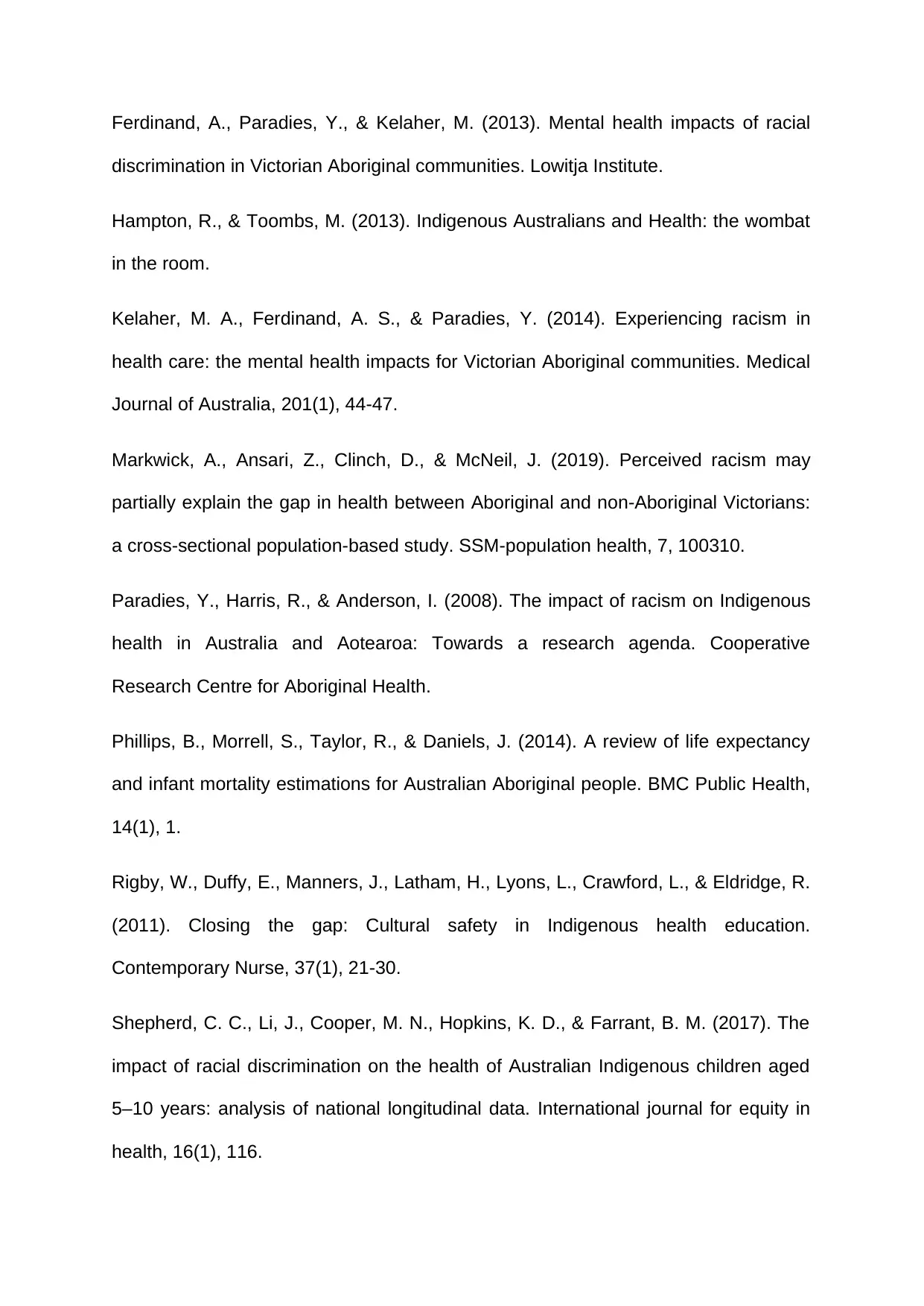
Ferdinand, A., Paradies, Y., & Kelaher, M. (2013). Mental health impacts of racial
discrimination in Victorian Aboriginal communities. Lowitja Institute.
Hampton, R., & Toombs, M. (2013). Indigenous Australians and Health: the wombat
in the room.
Kelaher, M. A., Ferdinand, A. S., & Paradies, Y. (2014). Experiencing racism in
health care: the mental health impacts for Victorian Aboriginal communities. Medical
Journal of Australia, 201(1), 44-47.
Markwick, A., Ansari, Z., Clinch, D., & McNeil, J. (2019). Perceived racism may
partially explain the gap in health between Aboriginal and non-Aboriginal Victorians:
a cross-sectional population-based study. SSM-population health, 7, 100310.
Paradies, Y., Harris, R., & Anderson, I. (2008). The impact of racism on Indigenous
health in Australia and Aotearoa: Towards a research agenda. Cooperative
Research Centre for Aboriginal Health.
Phillips, B., Morrell, S., Taylor, R., & Daniels, J. (2014). A review of life expectancy
and infant mortality estimations for Australian Aboriginal people. BMC Public Health,
14(1), 1.
Rigby, W., Duffy, E., Manners, J., Latham, H., Lyons, L., Crawford, L., & Eldridge, R.
(2011). Closing the gap: Cultural safety in Indigenous health education.
Contemporary Nurse, 37(1), 21-30.
Shepherd, C. C., Li, J., Cooper, M. N., Hopkins, K. D., & Farrant, B. M. (2017). The
impact of racial discrimination on the health of Australian Indigenous children aged
5–10 years: analysis of national longitudinal data. International journal for equity in
health, 16(1), 116.
discrimination in Victorian Aboriginal communities. Lowitja Institute.
Hampton, R., & Toombs, M. (2013). Indigenous Australians and Health: the wombat
in the room.
Kelaher, M. A., Ferdinand, A. S., & Paradies, Y. (2014). Experiencing racism in
health care: the mental health impacts for Victorian Aboriginal communities. Medical
Journal of Australia, 201(1), 44-47.
Markwick, A., Ansari, Z., Clinch, D., & McNeil, J. (2019). Perceived racism may
partially explain the gap in health between Aboriginal and non-Aboriginal Victorians:
a cross-sectional population-based study. SSM-population health, 7, 100310.
Paradies, Y., Harris, R., & Anderson, I. (2008). The impact of racism on Indigenous
health in Australia and Aotearoa: Towards a research agenda. Cooperative
Research Centre for Aboriginal Health.
Phillips, B., Morrell, S., Taylor, R., & Daniels, J. (2014). A review of life expectancy
and infant mortality estimations for Australian Aboriginal people. BMC Public Health,
14(1), 1.
Rigby, W., Duffy, E., Manners, J., Latham, H., Lyons, L., Crawford, L., & Eldridge, R.
(2011). Closing the gap: Cultural safety in Indigenous health education.
Contemporary Nurse, 37(1), 21-30.
Shepherd, C. C., Li, J., Cooper, M. N., Hopkins, K. D., & Farrant, B. M. (2017). The
impact of racial discrimination on the health of Australian Indigenous children aged
5–10 years: analysis of national longitudinal data. International journal for equity in
health, 16(1), 116.
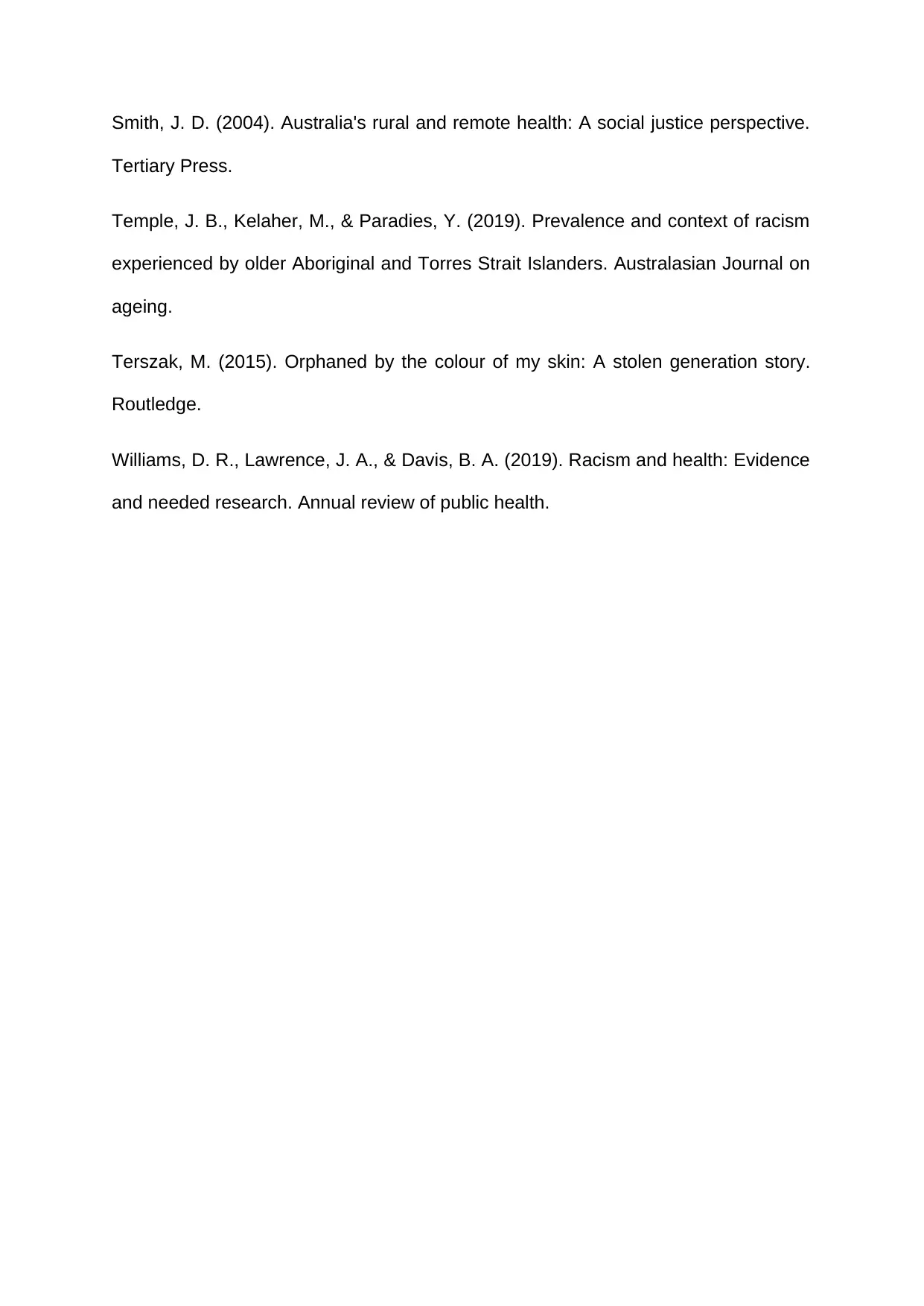
Smith, J. D. (2004). Australia's rural and remote health: A social justice perspective.
Tertiary Press.
Temple, J. B., Kelaher, M., & Paradies, Y. (2019). Prevalence and context of racism
experienced by older Aboriginal and Torres Strait Islanders. Australasian Journal on
ageing.
Terszak, M. (2015). Orphaned by the colour of my skin: A stolen generation story.
Routledge.
Williams, D. R., Lawrence, J. A., & Davis, B. A. (2019). Racism and health: Evidence
and needed research. Annual review of public health.
Tertiary Press.
Temple, J. B., Kelaher, M., & Paradies, Y. (2019). Prevalence and context of racism
experienced by older Aboriginal and Torres Strait Islanders. Australasian Journal on
ageing.
Terszak, M. (2015). Orphaned by the colour of my skin: A stolen generation story.
Routledge.
Williams, D. R., Lawrence, J. A., & Davis, B. A. (2019). Racism and health: Evidence
and needed research. Annual review of public health.
1 out of 13
Related Documents
Your All-in-One AI-Powered Toolkit for Academic Success.
+13062052269
info@desklib.com
Available 24*7 on WhatsApp / Email
![[object Object]](/_next/static/media/star-bottom.7253800d.svg)
Unlock your academic potential
© 2024 | Zucol Services PVT LTD | All rights reserved.





